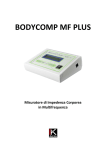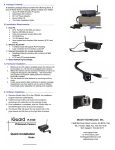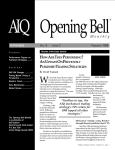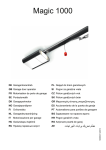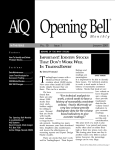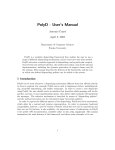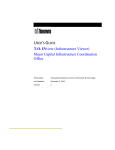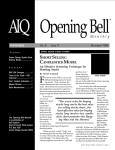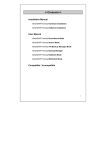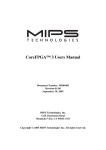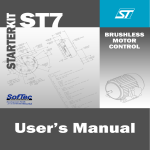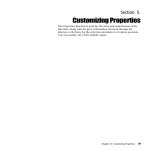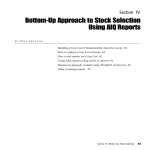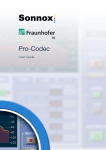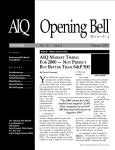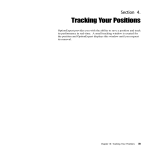Download January 1999 - AIQ Systems
Transcript
AIQ Opening Bell Monthly IN THIS ISSUE Feature A Test: Are You a Successful Market Timer? .................... 1 V OL . 8 I SSUE 1 MARKET TIMING DO YOU HAVE WHAT IT TAKES TO BE A SUCCESSFUL MARKET TIMER? S ec t i o n s By Paul A. Merriman Market Review .................... 3 arket timing works, and it works well for people who actually practice it as a discipline. In theory, every investor is capable of following the disciplines of timing. But not everybody has the right emotional makeup to do timing right. In real life, most people who try are ultimately unsuccessful. Readers Forum .................. 3 Mechanical Portfolio ........ 4 S&P 500 Changes .............. 6 EDS Short Model ............... 7 Data Maintenance ............. 8 The Opening Bell Monthly is a publication of AIQ Systems David Vomund, Chief Analyst P.O. Box 7530 Incline Village, Nevada 89452 J ANUARY 1999 M it takes a strong faith and a strong stomach. I like this quote from the legendary Benjamin Graham: To achieve satisfactory results is easier than most people realize. To achieve superior results is harder than it looks. Here are six questions to help you determine if you have what it takes. There are no right or wrong answers, only whats true for you. Timing puts invesSix Questions tors on the front lines, 1. Do you have the face to face with the necessary perserealities of the market, every business day. To verance? be a successful timer, Timing can get you youve got to buy and in real trouble if you try sell without flinching it for a while, become even when you dont discouraged, and then Paul A. Merriman feel like it. Youve got to abandon your plan in follow your discipline favor of something you find more even when youre sure its a mistake. palatable. If you let your feelings guide Youve got to do it even when you dont you, youre likely to bail out of a timing understand why your timing system is strategy at the very worst time, when telling you to act. Nike had it right: Just your investments are down. Can you do it. But its so much easier to say adopt a strategy and stick to it for the than to do! long term? Can you follow the system Timing is not for sissies. Sometimes regardless of how you feel about it and Market Timing continued on page 2 ® AIQ Opening Bell MARKET TIMING continued . . . regardless of whats going on around you? Can you resist the temptations to act on impulse? Can you ignore the many hot tips you may come upon every week? 2. Are you independent and self assured enough to resist the temptation to constantly look over your shoulder to see how somebody else is doing? There arent many certainties about investing, but heres something I can guarantee: No matter how your investments are doing, there will always be somebody who has recently outperformed you and seems to have struck it rich. Nervous investors constantly look over their shoulders, hoping to find somebody who has found the one true path to wealth. That path is a myth, and nervous investors dont make good timers. Confident, successful investors know what they want and need, adopt a strategy to achieve their objectives, and stick with that strategy regardless of what others are doing. If your goal is to increase your assets by 10 percent a year, and a timing system lets you achieve that, can you be satisfied even when other people are making 12 percent or 15 percent or even 20 percent? If so, you may have what it takes to succeed as a timer. 3. Can you accept that your portfolio will underperform the market? This should be obvious, but you would be surprised to know how many people forget it: A timing system is not designed to produce the same returns as the untimed market. When you outperform the market, you are likely to be pleased. But your pleasure may be mild compared with the fury or betrayal you can experience when your portfolio is underperforming and when your timing system produces a losing trade. Thats especially true when you just knew that the signal you got from your system was the wrong thing to do. 2 4. Can you accept that your timing system will be imperfect? Imperfection is one of the medias biggest criticisms of timing. When you are underperforming and experiencing losing trades, that media criticism may shake your confidence. The media often says market timing requires you to be right twice: when you buy and when you sell, in contrast to a buy-and-hold approach in which you have to be right only once: when you buy. Most of the time, you can count on your system to get you into or out of the market too soon or too late to catch the tops and bottoms. If getting out at the very top and getting back in at the very bottom are your goals, timing is guaranteed to let you down. And if that failure will drive you nuts, think twice before embarking on a timing strategy, because what you will perceive as timing mistakes will erode or destroy your willingness to follow the discipline. Your goal should not be to achieve perfection. It should be to put the probabilities on your side. And a good timing strategy will do that. 5. Can you ignore the mass media? Almost unanimously, the popular press seems to have a blind spot when it comes to timing. They say timers are misguided, and this view is widely echoed by the mutual fund and brokerage industries. Can you pull out of the market when everybody else is either getting in or already making money? Can you get back in when your friends, colleagues, the media and possibly your own gut are telling you its a dumb idea? 6. Are you decisive? Some people stew and fret and delay making decisions, even when they are convinced they should be doing something. They are unlikely to be successful timers. Successful timing requires quick action to move into and out of the markets. One of the most obvious truths about timing (and one of the most widely overlooked) is that by the time your friends, your colleagues, your gut and the experts all agree on what you should do, its already far too late for you to extract the maximum opportunity from it. If you usually take lots of time to make decisions, this is not a suitable arena for you. The bottom line for me is that timing is very challenging. I believe that for most investors, the best route to success is to have somebody else make the actual timing moves for you. You can hire a professional. Or you can have a colleague, friend or family member actually make the trades for you. That way your emotions wont stop you from following the discipline. Youll be able to go on vacation knowing your system will be followed. Most important, youll be one step removed from the emotional hurdles of getting in and out of the market. n Paul Merriman is president of Paul A. Merriman & Associates, an investment advisory firm specializing in buy-andhold and market timing strategies using no-load mutual funds. He is also editor of FundAdvice.com, a free internet mutual fund newsletter and free e-mail market timing service. For a free copy of his latest audiotape, The ultimate 20% Strategy, call 1-800-423-4893. PLEASE SEND CORRESPONDENCE TO: Opening Bell Monthly G.R. Barbor, Editor P.O. Box 7530 Incline Village, NV 89452 AIQ Opening Bell Monthly does not intend to make trading recommendations, nor do we publish, keep or claim any track records. It is designed as a serious tool to aid investors in their trading decisions through the use of AIQ software and an increased familiarity with technical indicators and trading strategies. AIQ reserves the right to use or edit submissions. For subscription information, phone 1-800-332-2999 or 1-702-831-2999. © 1992-1999 , AIQ Systems JANUARY 1999 AIQ Opening Bell MARKET REVIEW D ecember was an active month for AIQs market timing model. After being on a buy from October 8, the system finally switched to a sell mode when it registered a 98 down signal on December 3. A repeat sell came on December 10 when a 99 down was registered. Negative market breadth played a big role in both sell signals. Looking at the market log, more than 80% of the stocks giving unconfirmed signals were on the buy side, an indication that it wasnt a major top. After the sell, the Dow decreased some but there was little downward movement. During the sell, the Russell 2000 representing small company stocks was in a trading range. It wasnt until Christmas that the Russell 2000 broke out of its trading range (see Figure 1). The week between Christmas and the New Year is typically bullish for stocks. This year was no exception. After the Russell 2000 broke out, market breadth improved and a 96 buy signal was registered on December 29. Early in the month, the upward movement was limited to technology and internet companies. Late in the month, market participation began to improve. For the year, technology groups were the biggest winners. Fidelitys Computers sector fund gained an amazing 95%, and their Technology Figure 1 fund gained over 70%. The worst groups were oil related. Fidelitys Energy Service sector fund, which contains oil equipment and drilling stocks, lost 50% and their Energy fund fell 15%. n READERS FORUM T his Question & Answer feature will appear regularly in the Opening Bell. Send your questions to Editor, Opening Bell, P.O. Box 7530, Incline Village, NV 89452. Q: I have a stock in my database that has recently changed symbols. How do I rename the symbol and keep all the old history? A: In Data Manager, highlight the old symbol. Then click on Ticker and choose Rename. Enter the new symbol, description, and market if needed. This will rename the old symbol and also retain all its history. Q: I am a flat fee subscriber to Dial/Data but when I do an End of Day download a cost appears on the Communications log. Is this cost in addition to the flat fee? A: No. This cost no longer applies and should be disregarded. It is simply leftover from the days when data services charged per-quote fees. All services now charge on the basis of flat fee subscriptions. Q: When I press the ER button JANUARY 1999 while viewing a ticker to review rules that have fired on a buy (or sell) signal, why do I sometimes see rules that are contrary to the ER signal? A: It is true that one or more contrary rules may appear regardless of the magnitude of the ER. They are shown because all rules, including contrary rules, have a bearing on the ER. However, contrary rules are more likely for an ER of 95-5 than for an ER of 100-0. In effect, contrary rules downgrade the ER and without the firing of a contrary rule a higher ER would very probably be generated. Q: When I update my data at night, I am unable to get the current days data. This happens even when the time is after the current quotes are posted at the data vendor. What should I do? A: Check your system date and time. If your date is current, ensure that the time and a.m./p.m. designation are correct. Also, in Data Retrieval click on Setup Options and make sure the market open and market close are set correctly for your time zone. Q: Do I need to have the MyTrack program running in order to use Real Time in Trading Expert Pro? A: No. MyTrack is a separate program and does not have to be running. Bug Fix for TradingExpert Pro There is a service pack available on the internet that fixes many of the known bugs in the TradingExpert 5.0 software. To download the service pack, go to AIQs Quick Launch Menu and select Help from the menu bar. Next, select Technical Support and then Product Updates. That will launch a web page. On that page you can download Service Pack 1, which is a choice in the lower portion of the screen. To get a list of what features are corrected with the Service Pack, choose Known Issues. 3 AIQ Opening Bell YEAR-END ANALYSIS THE BEST YEAR YET FOR AIQS MECHANICAL TRADING PORTFOLIO By David Vomund T he year 1998 was the best yet for AIQs mechanical trading strategyup an amazing 76.78%. The strategy combines the market timing model with the individual stock buy and sell signals. Before we examine the strategy, lets first look at how the market timing model fared in 1998. major top. Unfortunately, the model registered a buy signal soon after the market began to drop. A buy came on July 29 and the system remained on a buy until early September. The market experienced a 12.7% loss over this time period, which represents the largest loss our system has experienced since it was introduced in early 1987. Just when confidence in the market timing model was shaken, the system registered a buy on October 8, which represents the low point in the S&P 500, Nasdaq Composite, and Russell 2000. The S&P 500 rallied the confirmation delay. The benefit of using confirmation came during the late summer selloff. The July 29 sell signal was registered in a falling market. It wasnt until August 17 that the market rallied enough to bring an increase to the Phase indicator. When the buy signal came at the October 8 low, it wasnt immediately confirmed so once again some of the profit was lost. In the end, the market timing model gained 23% using Phase confirmation in 1998. The individual trades are shown in Table 2. Market Timing No Confirmation In 1998, AIQs market AIQ's Mechanical Trading timing model had some periods Portfolio of brilliance and some periods This (mechanical) strategy, which We now will review our where it was off the mark. In combines the market timing Expert mechanical model that uses the end, the results were in line Ratings with the top stocks on the both Expert Ratings on the with a buy-and-hold return, overall market and on indiwhich is better than what most Weighted Action List report, was vidual stocks. timers can claim. introduced in May 1992... This was This strategy, which The model started the year combines the market timing the strategys best year. on a buy and was on a buy for Expert Ratings with the top all but two trading days until stocks on the Weighted Action April 17. That was impressive List report, was introduced in the May 20% after that buy until a sell was because it avoided giving a sell signal 1992 Opening Bell and weve followed registered in early December. in a market environment that turned it each year after that. This was the Despite the late summer setback, if out to be very bullish. From the strategys best year. you traded the S&P 500 based on the January 12 buy signal to the April 17 The following is a review of this Expert Ratings you would have seen a sell signal, the S&P 500 rallied 20%. mechanical strategy: 28.5% return in 1998. The buy-andThe April 17 sell signal was hold return was 26.7%. The indiWe ran a Weighted Action List perfectly timed as the large company vidual trades are shown in Table 1. report every time there was a market stocks ended their uptrend and began timing buy signal (an Expert Rating of to move sideways. At the same time, Market Timing With Confirma95 or greater). Only the first signal in small company stocks entered into a tion a string of buy signals was used and bear market. The April 17 sell signal no confirmation was applied. The top In past articles, we have reported was registered three days before the five stocks that appeared on the that applying a confirmation techRussell 2000 hit its highest level, a Weighted Action List were purchased nique typically lowers both risk and level that has yet to be penetrated. and held until a market sell signal return. That was the case in 1998. A quick and profitable trade was registered, at which time all Since the AIQ market timing model occurred from mid-June to mid-July. positions were moved to cash. Only was deadly accurate in the first half of For the first half of the year, the market stocks over $10 were purchased and the year, applying a Phase confirmatiming model could hardly have been the Expert Rating buy signals on the tion meant that you acted on the better. But that is when the trouble stocks had to be 95 or greater. signals a few days after they were started. The July 21 sell signal was registered. The return from each trade To obtain percentage return well timed as it was registered only was lowered by about 2% as a result of figures, we made the following two days after the market formed a 4 JANUARY 1999 AIQ Opening Bell YEAR-END ANALYSIS continued . . . assumptions: Table 1 All profits/losses were reinvested in the next block of trading with each of the five stocks receiving an equal amount of capital. No Confirmation The buy and sell points of the stocks were the opening price the day after the market Expert Rating. Commissions were factored in using a flat rate of $20 per trade. Slippage, dividends, and money market interest received were not factored in. The trade-by-trade details are found in Table 3. The market timing buy and sell signal dates are listed in the first two columns. The third column lists the percentage change in the S&P 500 index, while the fourth column shows the results of trading the five stocks listed in the far right column (top five stocks from the Weighted Action List) using the opening price the day after the market timing signal. ER Buy Date ER Sell Date S&P 500 Buy Price S&P 500 Sell Price S&P 500 % Change 12/31/97 01/08/98 970.42 956.04 -1.48 01/12/98 04/17/98 939.20 1122.72 19.54 06/02/98 06/10/98 1093.02 1112.28 1.76 06/16/98 07/21/98 1087.58 1165.06 7.12 07/29/98 09/03/98 1125.20 982.26 -12.70 09/08/98 10/05/98 1023.46 988.56 -3.41 10/08/98 12/03/98 959.44 1150.14 19.88 12/29/98 12/31/98 1241.80 1229.40 -1.00 1998 Return = 28.47% A yearly breakdown of this strategy is as follows: The return for 1998 is an amazing 76.78%, including commissions. Since the portfolio is limited to S&P 500 stocks, the high return is not a result of internet speculation. This demonstrates that good stock selection is much more important than good market timing. 1992 13.53% 1993 17.26% 1994 35.75% 1995 18.90% 1996 27.88% 1997 37.73% 1998 76.78% Average 32.55% First, people start to follow the strategy until there is a bad period. After the 8% drop in August, few people stuck with the strategy and failed to purchase the five stocks from the October 8 signal. Table 2 Phase Confirmation Buy Date Sell Date 12/31/97 S&P 500 Buy Price S&P 500 Sell Price S&P 500 % Change 01/08/98 970.42 956.04 -1.48 01/14/98 04/20/98 957.94 1123.64 17.30 06/05/98 06/10/98 1113.86 1112.28 -0.14 06/17/98 07/21/98 1107.10 1165.06 5.24 08/17/98 09/03/98 1083.66 982.26 -9.36 09/08/98 10/05/98 1023.46 988.56 -3.41 10/09/98 12/03/98 984.32 1150.14 16.85 12/29/98 12/31/98 1241.80 1229.40 -1.00 1998 Return = 22.99% When we publish an article on this mechanical strategy, two things invariably happen. Second, people try to duplicate our results and find that the stocks on their Weighted Action List are different than what we are reporting. This can happen for a variety of reasons. One reason is that we are buying stocks with Expert Rating signals that are greater than 95. The default on the Weighted Action List report uses an Expert Rating value of 90. Therefore, you should change the UP ER Criteria on the Weighted Action List report to 95 (see page 244 in the TradingExpert Pro user manual). In addition, only Standard & Poors 500 stocks are purchased using this strategy so the reports should be generated on the S&P 500 list instead of the entire database (see page 234 in the TradingExpert Pro manual). Because the stocks in the S&P 500 index change over time, your S&P 500 Year-End Analysis continued on page 6 JANUARY 1999 5 AIQ Opening Bell YEAR-END ANALYSIS continued . . . structure needs maintenance. Since each program that we send out has a current S&P 500 structure, those of you who have upgraded to TradingExpert Pro and have been using a Standard & Poors structure from several years ago should reinstall the structure from the current program disk. To do this, first go to the Data Manager application and make the S&P 500 structure the active structure. Then select List and Delete. Table 3 1998 Results - Weighted Action List ER Buy Date ER Sell Date 12/31/97 01/12/98 06/02/98 06/16/98 07/29/98 09/08/98 10/08/98 12/29/98 01/08/98 04/17/98 06/10/98 07/21/98 09/03/98 10/05/98 12/03/98 12/31/98 S&P 500 Stocks Portfolio Holdings % Change % Change (Stock Symbols) -1.48 19.54 1.76 7.12 -12.70 -3.41 19.88 -1.00 4.93 31.30 5.83 12.15 -8.19 -1.97 20.24 0.68 1998 Return = 76.78% After deleting the old structure, you can then install the newer structure from the TradingExpert Pro CD. You application and delete all the stocks in can do this by performing a Custom the S&P 500 list (see page 64 in your installation and then installing only TradingExpert Pro manual). the S&P 500 files (see installation Next, you will want to install the instructions in your New Users Guide S&P 500 stocks from the AIQ Data CD. if you need help). In Data Manager, use the Ticker Import By doing the above, you will get a Utility and install all the stocks in S&P recent structure. But you will also 500 list (see page 42 in the want to make the changes to the S&P TradingExpert Pro manual). 500 structure as they occur. To get a Each time there is a new AIQ list of the changes in the structure or a market timing buy signal, I delete and list of the current S&P 500 stocks, visit reinstall the stocks from the historical Standard & Poors web page at Data CD just to make sure the data is www.spglobal.com. The News section accurate. Users can receive quarterly will list the changes. Starting with this issue, we will list recent changes to the S&P 500 structure in the Opening Bell. Data quality is very important to those who want to follow this mechanical strategy. TradingExpert Pro makes it much easier for you to get the same list of stocks that we get when we follow the system. It is best to install all the stocks in the S&P 500 from the AIQ (historical) Data CD even if you feel that all the S&P 500 stocks are in your database. With TradingExpert Pro, you can delete all the stocks in the S&P 500 structure and then install all the stocks in the structure from the Data CD. To delete the stocks in the S&P 500 list, use the Advanced Ticker Delete function found in the Data Manager 6 EMC,UIS,ADSK,BAY,DELL DH,FJ,DELL,X,ABT LEH,DGN,LUV,SFA,KBH MG,PFE,TWX,MCIC,ADSK PDG,APC,PPW,MIR,BEL AAPL,UMG,UIS,CMCSK,LUV LEH,BSX,BSC,NMK,MCD LUV,AGN,DH,CCE,TMK CD updates for $99 per year. This process may seem excessive but it helps to insure that the Weighted Action List signals are accurate. When real money is on the line, an extra hour of work on days that AIQ registers a market timing buy signal is a small price to pay. n David Vomund publishes VIS Alert, a weekly investment newsletter. For a sample copy go to www.visalert.com or call (702) 831-1544. Changes to S&P 500 Index and Industry Groups The following are recent changes to the Standard & Poors 500 structure: 1. (FSR) Firstar Corp. replaces (AN) Amoco Inc. (FSR) added to the Financial Banks Major group. 2. (CCL) Carnival Corp. replaces (GRN) General Re. (CCL) added to the Leisure Lodging Hotel group. 3. (CPWR) Compuware Corp replaces (SAI) SunAmerica. (CPWR) added to Computer Software group. 4. (AOL) America Online replaces (Z) Venator Group. (AOL) added to Computer Software group. 5. (SLR) Solectron Inc replaces (PZL) Penzoil. (SLR) added to Electrical Equipment group. JANUARY 1999 AIQ Opening Bell EDS MODELS FOLLOW-UP ANALYSIS ON OUR EDS SHORT MODEL By David Vomund DAVID VOMUND I to 61 trades per year. Some people expressed an interest for more trades. If you want more trades, simply ease the parameters on the Directional Movement and VaPct rules. By requiring the Directional Movement indicator be less than 20 instead of less than 25, 100 more trades are produced and the effectiveness drops only slightly. would have shorted the S&P 500 index instead of shorting the stocks, the average short trade would have lost 0.3%. n the December, 1998 issue of the This leads to the question: can this Opening Bell, we created a highly model be used as a market timing effective Expert Design Studio model? That is, when a lot of stocks (EDS) model for shorting Standard & appear on the EDS report on a given Poors 500 stocks. We received a lot of day does that mean the market will positive feedback on this model, and move lower? we expect that many AIQ users will To answer this question, use it in the year to come. The we exported the EDS Positions analysis in this follow-up We expect many AIQ users will use page to an excel spreadsheet, article should help people to this model in the year to come. This manipulated the data, and further understand how the then used the Data Transfer analysis should help people to further model works. Utility to import the data back To quickly review the understand how the model works. to AIQ (I wouldnt recommend model, there are only three this process to anyone!). simple criteria that must be From our testing results we know The end result of this exercise is met before a stock can be selected as a that the model is effective in picking displayed in Figure 3. In this graph, short candidate. First, the stock must short candidates. In Figure 2, we see we show the S&P 500 along with the move from below to above its Lower that the average short position gained number of stocks in the S&P 500 that ESA. Second, the stocks Directional 1.72% (excluding commissions) with Movement indicator must be less than EDS Models continued on page 8 an 11 day holding period. If you 25. Third, the stocks Volume Accumulation Percent indicator must Figure 2 be less than 20. The actual model can be downloaded off AIQs web page at www.aiq.com. The EDS file can be found under the Educational Products folder. When we introduced the model in December, we ran the test using a fixed 10-day holding period. The results of the test are very similar if you use one of AIQs traditional stop techniques. In Figure 2 we are displaying the testing results of shorting stocks using a sell strategy of 95% principal protect, and 90% profit protect after a gain of 5%. For those who want a longer holding period, try a 90% principal protect and 90% of profit after a 10% gain. Over the three-year testing period, there were 184 trades, which equates JANUARY 1999 7 AIQ Opening Bell EDS MODELS continued . . . appear as short selections using the EDS model. The price scale for the S&P 500 appears on the right while the scale that corresponds to the number of short selections is on the left (a future version of the EDS software will have the ability to produce this graph). Figure 3 One element is immediately apparent. When the market is in a strong uptrend, no stocks are selected by the short model. No short selections appear from May 97 to August 97 as the market moved higher. Similarly, no stocks appeared from mid-January 98 to May of 98. More recently, a short candidate appeared nearly every day from July to mid-September, 1998 and there hasnt been a single selection from midOctober through the end of our testing time period. When the market environment is shaky, the model produces selections and the stocks selected are good short candidates. However, the model is not good at calling market tops. The majority of the selections come after the market has rolled over. In fact, the time that the most stocks were selected as short candidates came at a near term low. In midJune 98, there was a day in which eight stocks appeared. This occurred just before the market staged its final advance before the fall correction. This analysis should help people to better understand how often signals are registered as well as how the model works. n STOCK DATA MAINTENANCE The following table shows past and future stock splits and large dividends: Stock Ticker Split/Div. Approx. Date Stock Ticker Split/Div. Approx. Date Dycom Indust. DY 3:2 01/05/99 VISX Inc. VISX 2:2 01/14/99 CMGI Inc. CMGI 2:1 01/11/99 Transamerica Corp. TA 2:1 01/18/99 Gallery of History HIST 2:1 01/11/99 Astec Ind. ASTE 2:1 01/19/99 Flextronics FLEXF 2:1 01/12/99 Sonic Automotive SAH 2:1 01/26/99 Intervoice Inc. INTV 2:1 01/12/99 Guidant Corp. GDT 2:2 01/28/99 Trading Suspended: CKS Group (CKSG), Cliffs Drilling Co. (CDG), DeKalb Genetics Corp. (DKB), Special Devices (SDII) Name/Ticker Changes: CMG Information Svs (CMGI) to CMGI Inc. (CMGI), Key Energy Group (KEG) to Key Energy Services Inc. (KEG), Washington Mutual (WAMU) to Washington Mutual Inc. (WM), Westwood One (WONE) to Westwood One Inc. (WON) 8 JANUARY 1999









